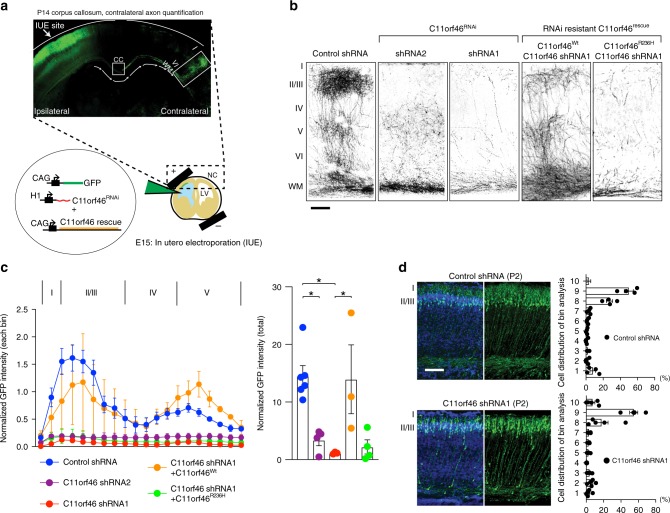Fig. 2.
Suppression of C11orf46 impairs callosal development and interhemispheric connectivity. a (top) Schematic representation of in utero electroporation of GFP expressing plasmid into somatosensory cortex at E15. (bottom) P14 somatosensory cortex expressing GFP in pyramidal neurons at IUE injection site (Ipsilateral side) and axonal projections between layer I–VI (Contralateral side). b Knockdown of C11orf46 in pyramidal neurons of layer II/III (Ipsilateral) show impaired axonal terminal arborization in the contralateral somatosensory cortex at P14. C11orf46 shRNA1 had a stronger axonal arborization impairment than shRNA2 when compared with control shRNA (first 3 panels); this axonal deficit was partially rescued by co-expressing RNAi resistant wild-type C11orf46 (C11orf46Wt), but not by R236H mutant (C11orf46R236H) (last 2 panels). Scale bar, 100 µm. c Layer distributions (left) and total axonal density (right) of callosal axons in the contralateral site of the electroporated brains were shown as normalized immunofluorescence intensities of callosal axons. F (4, 15) = 7.9591, P = 0.0012 was determined by one-way ANOVA with post hoc Bonferroni test. Three to six mice per condition. *P < 0.05. Impaired axon terminal arborization across all cortical layers elicited by C11orf46 knockdown was restored by overexpression of C11orf46Wt, but not by overexpression of C11orf46R236H. d C11orf46 knockdown did not have an effect on radial neuronal migration at P2. Scale bar, 50 μm. Bar graphs indicate mean ± S.E.M (c, d)

